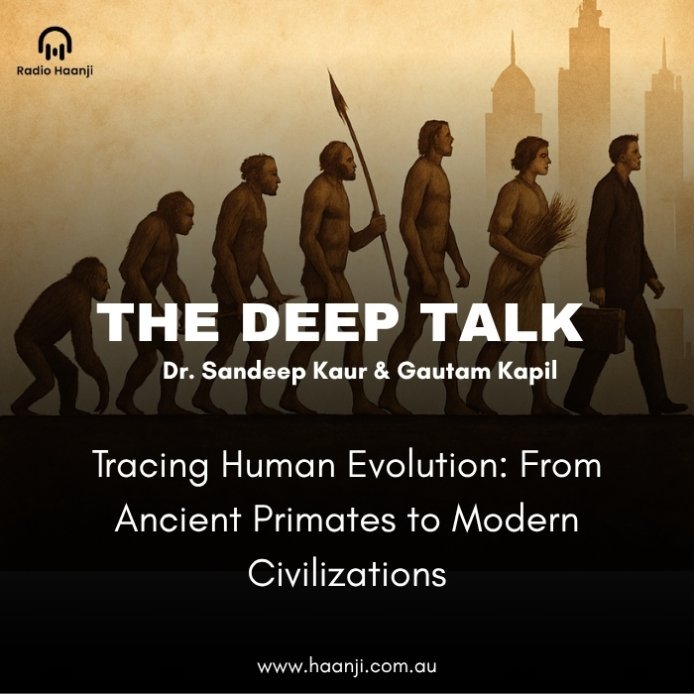
Tracing Human Evolution: From Ancient Primates to Modern Civilizations
Host:-
 Dr. Sandeep Kaur
Dr. Sandeep Kaur
 Gautam Kapil
Gautam Kapil
Explore human evolution from ancient primates in Africa to modern civilizations, covering bipedalism, brain growth, and communication. Learn more now!
Unravel the fascinating journey of human evolution, from ancient primates to modern societies. Today’s episode of Deep Talk on Radio Haanji, hosted by Gautam Kapil and Dr. Sandeep Kaur, dives into how humans evolved from our primate ancestors, starting in Africa around 6 million years ago. This article explores the remarkable transformation of hominins, highlighting key characteristics like bipedalism, large brains, and advanced communication that shaped modern humans and their civilizations. Whether you're curious about our origins or seeking insights into what makes us unique, this guide offers a clear and engaging look at our evolutionary story.
The Origins of Human Evolution in Africa
Human evolution began approximately 6–7 million years ago in Africa, where the earliest hominin fossils have been discovered. Scientists widely accept Africa as the cradle of humanity, with fossils like Sahelanthropus tchadensis (7 million years ago) and Orrorin tugenensis (6 million years ago) providing critical evidence. These early hominins mark the divergence from our closest relatives, chimpanzees and bonobos, with whom we share a common ancestor. Molecular evidence suggests this split occurred between 8 and 4 million years ago, setting the stage for the development of distinctly human traits.
- Key Fossil Discoveries:
- Sahelanthropus tchadensis: Found in Chad, this 7-million-year-old cranium shows early signs of bipedalism.
- Orrorin tugenensis: Discovered in Kenya, dated to 6 million years ago, with femur bones indicating upright walking.
- Ardipithecus ramidus: Known as “Ardi,” this 4.4-million-year-old fossil from Ethiopia reveals a mix of arboreal and bipedal traits.
The African landscape, with its mix of woodlands and grasslands, created an environment where early hominins adapted to survive. The shift from forested to more open habitats likely drove evolutionary changes, such as bipedalism, which allowed our ancestors to move efficiently across varied terrains.
What Are Hominins and How Are They Different from Other Primates?
Hominins are a group of primates that includes modern humans (Homo sapiens) and our extinct ancestors, distinguished by traits like upright posture and bipedal locomotion. Unlike other primates, such as chimpanzees or gorillas, hominins evolved adaptations that set them apart from their arboreal cousins.
Key Characteristics of Hominins
- Bipedalism: Walking on two legs, a hallmark trait that emerged over 4 million years ago, as seen in fossils like Australopithecus afarensis (e.g., Lucy).
- Reduced Canine Teeth: Smaller canines compared to other primates, indicating dietary and social changes.
- Larger Brains: A gradual increase in brain size, particularly in the genus Homo, with Homo erectus showing a 50% brain size increase over earlier hominins.
- Tool Use: Evidence of stone tools from 3 million years ago suggests technological advancements.
- Skeletal Adaptations: A specialized pelvis and S-shaped spine for upright walking, unlike the C-shaped spine of other primates.
These traits didn’t develop overnight. Over millions of years, hominins adapted to their environments, with natural selection favoring characteristics that improved survival and reproduction.
The Evolution of Bipedalism: Why Did Humans Start Walking Upright?
Bipedalism, the ability to walk on two legs, is one of the earliest defining traits of hominins, emerging over 4 million years ago. Fossils like Australopithecus afarensis (e.g., Lucy, dated to 3.2 million years ago) show skeletal adaptations for upright walking, such as a wider pelvis and angled femur bones. But why did this trait evolve?
Theories Behind Bipedalism
- Energy Efficiency: Bipedalism allowed early hominins to travel longer distances with less energy, ideal for foraging in open landscapes.
- Freeing Hands: Upright posture freed hands for carrying food, tools, or infants, as supported by archaeological evidence of early tool use.
- Thermoregulation: Standing upright reduced sun exposure in hot African climates, helping regulate body temperature.
- Social Display: Some theories suggest bipedalism aided in signaling or mating displays, though this is less widely accepted.
Bipedalism marked a significant shift, enabling hominins to explore new environments and eventually migrate out of Africa, as seen with Homo erectus around 1.9 million years ago.
How Did Large Brains Shape Human Evolution?
The increase in brain size is a defining feature of human evolution, particularly in the genus Homo. While early hominins like Australopithecus had brain sizes similar to chimpanzees (around 400–500 cc), Homo erectus exhibited a significant jump to 800–1,000 cc. Modern humans (Homo sapiens) have an average brain size of 1,350 cc, enabling complex cognition and problem-solving.
Factors Driving Brain Growth
- Dietary Changes: Access to calorie-rich foods, like meat, supported brain development. Evidence of butchered animal bones from 2.6 million years ago suggests early hunting.
- Tool Use: The creation and use of stone tools, starting around 3 million years ago, required planning and dexterity, favoring larger brains.
- Social Complexity: Living in groups demanded cooperation and communication, driving neurological advancements.
- Environmental Challenges: Adapting to diverse climates, especially during migrations, required problem-solving skills.
Table: Brain Size Evolution in Hominins
Species
Brain Size (cc)
Time Period (mya)
Australopithecus
400–500
4–2
Homo habilis
600–700
2.4–1.4
Homo erectus
800–1,000
1.9–0.1
Homo sapiens
1,350
0.3–present
Larger brains enabled advanced cognitive abilities, setting the stage for communication and cultural development.
The Role of Communication and Socialization in Human Evolution
Communication and socialization are cornerstones of human evolution, distinguishing Homo sapiens from other hominins. While early hominins likely used basic vocalizations and gestures, the development of complex language around 100,000 years ago revolutionized human societies.
How Did Communication Evolve?
- Early Vocalizations: Evidence from fossilized hyoid bones (e.g., in Homo heidelbergensis, 600,000 years ago) suggests the physical capability for speech.
- Symbolic Thought: Cave art and carvings from 40,000 years ago indicate symbolic communication, a precursor to language.
- Social Cooperation: Group hunting and tool-making required coordinated efforts, as seen in archaeological sites like Zhoukoudian, China.
- Language Development: Modern human language likely emerged with Homo sapiens, enabling storytelling, planning, and cultural transmission.
Socialization and Civilization
Social structures became more complex as hominins lived in larger groups. Archaeological evidence, such as hearths and settlements from 500,000 years ago, points to communal living. These social bonds fostered:
- Division of Labor: Tasks like hunting, gathering, and childcare were shared, increasing efficiency.
- Cultural Development: Rituals, art, and music, evident from 100,000 years ago, strengthened group identity.
- Technological Advancements: Innovations like fire use (1 million years ago) and agriculture (10,000 years ago) supported population growth and settled communities.
Communication and socialization laid the foundation for advanced civilizations, enabling humans to build societies, share knowledge, and innovate.
Key Fossil Discoveries That Shaped Our Understanding
Fossils provide critical insights into human evolution, with Africa yielding the most significant finds. Below are some pivotal discoveries discussed on Deep Talk:
- Lucy (Australopithecus afarensis): Discovered in 1974 in Ethiopia, this 3.2-million-year-old skeleton showed bipedalism preceded brain enlargement.
- Turkana Boy (Homo erectus): Found in Kenya, this 1.6-million-year-old skeleton revealed a modern human-like gait and larger brain.
- Mrs. Ples (Australopithecus africanus): A 2.1-million-year-old skull from South Africa, showing transitional features between apes and humans.
These discoveries, combined with genetic and archaeological evidence, confirm Africa as the birthplace of humanity and highlight the gradual nature of evolutionary changes.
How Did Humans Build Advanced Civilizations?
The transition from nomadic hunter-gatherers to complex civilizations was driven by key evolutionary advancements:
- Agriculture: Starting around 10,000 years ago, farming allowed permanent settlements, as seen in sites like Çatalhöyük, Turkey.
- Writing Systems: Developed around 5,000 years ago, writing enabled record-keeping and knowledge transmission.
- Technology and Tools: From stone tools to metallurgy, technological progress supported population growth and urbanization.
- Social Hierarchies: Complex societies required leadership and governance, evident in early cities like Mesopotamia.
These advancements, rooted in our evolutionary traits, enabled humans to create the diverse and sophisticated societies we see today.
FAQs About Human Evolution
What is the earliest evidence of human evolution?
The earliest evidence comes from Sahelanthropus tchadensis, a 7-million-year-old fossil found in Chad, Africa, showing signs of bipedalism. This marks the divergence of hominins from other primates.
Why did humans evolve larger brains?
Larger brains evolved due to dietary changes, social complexity, tool use, and environmental challenges. For example, Homo erectus had a brain size of 800–1,000 cc, driven by hunting and social cooperation.
How did communication shape human societies?
Communication, especially language, enabled planning, storytelling, and cultural transmission. Evidence like cave art from 40,000 years ago shows symbolic thought, a key step toward complex societies.
Conclusion
Human evolution is a remarkable journey, from the earliest hominins in Africa to the advanced civilizations of today. Traits like bipedalism, larger brains, and complex communication, as explored on Deep Talk with Gautam Kapil and Dr. Sandeep Kaur, have defined our species. By understanding our origins, we gain insight into what makes us human. Share your thoughts in the comments, explore more on human evolution, or tune into Radio Haanji for more engaging discussions!
What's Your Reaction?
































































































